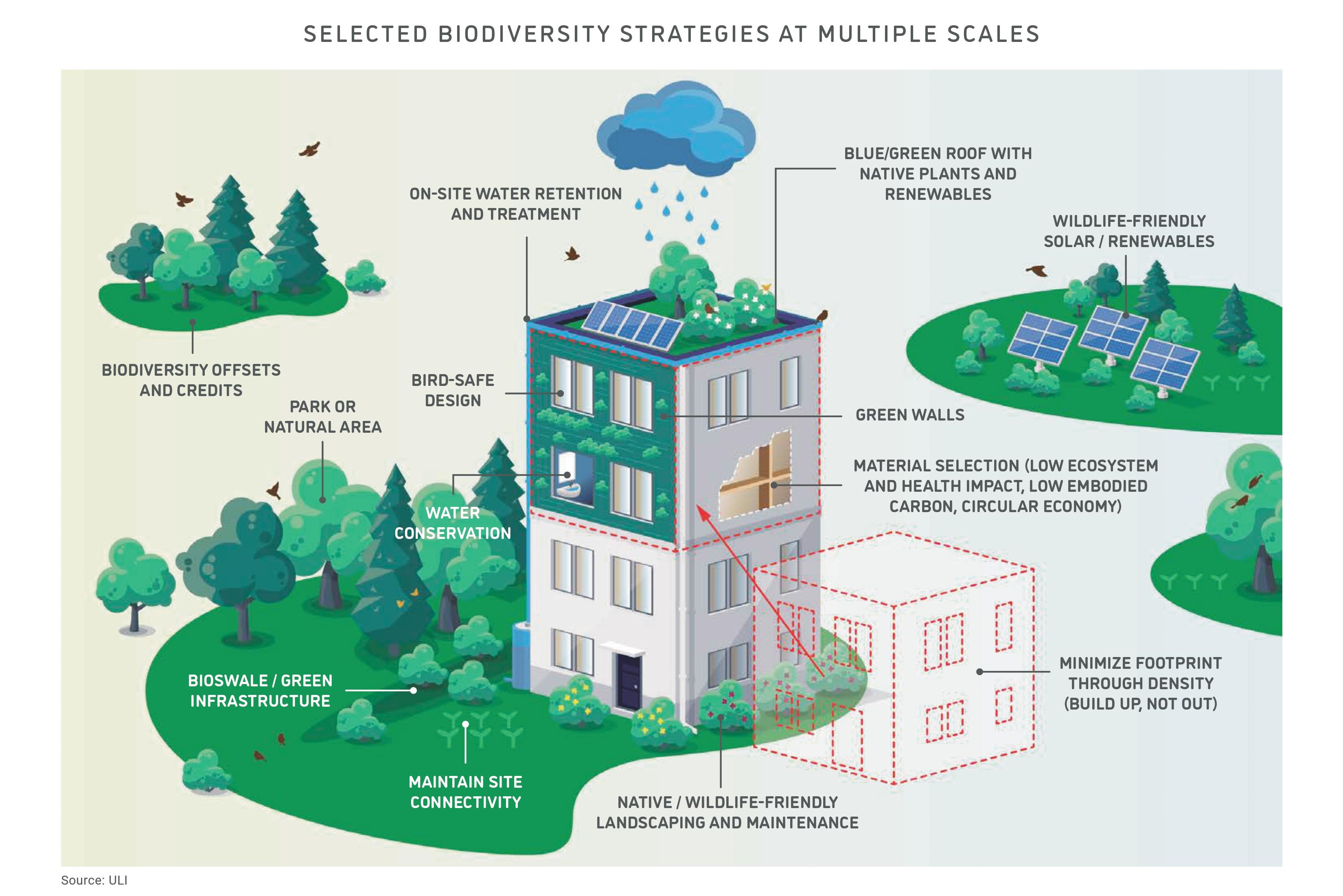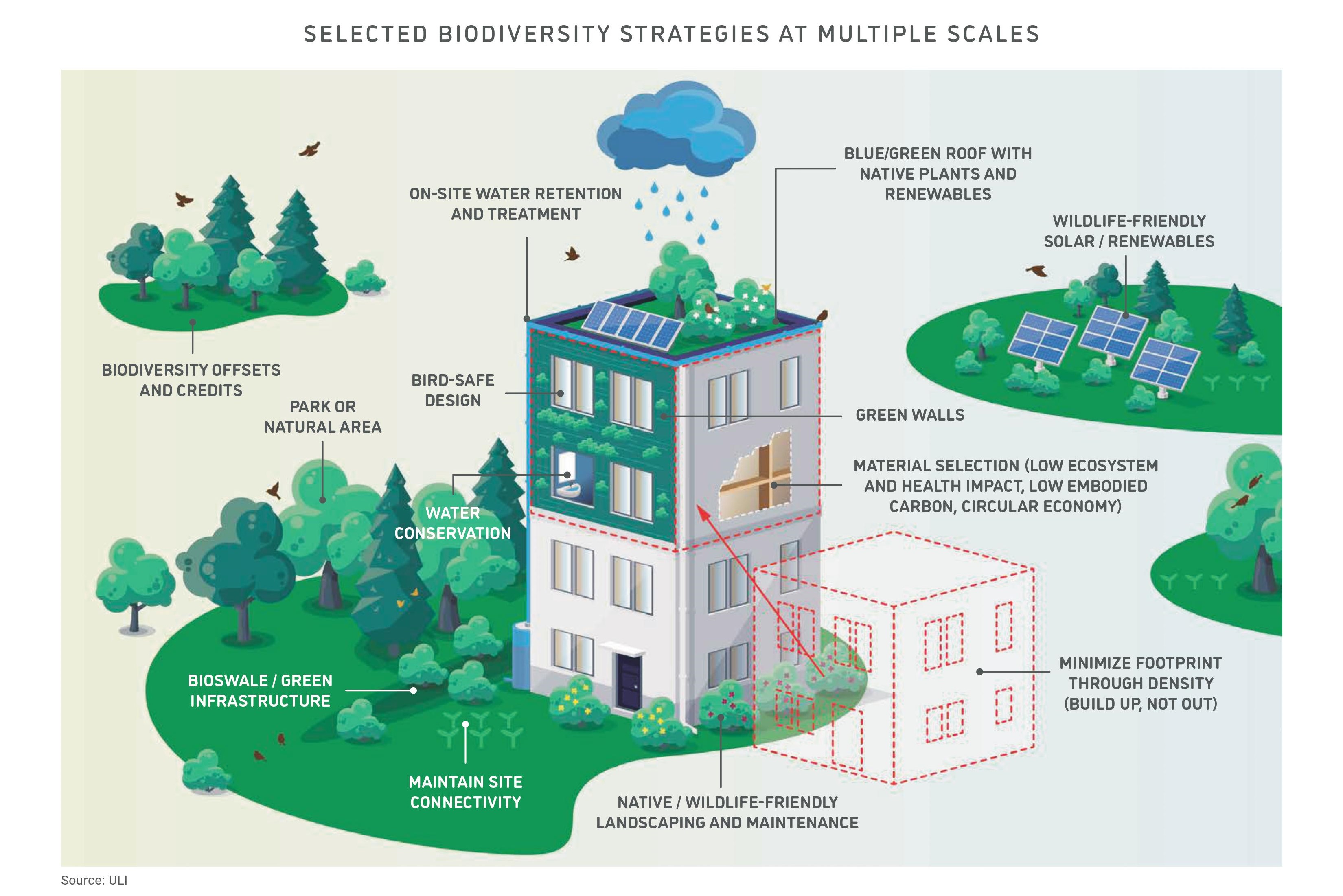Nature Positive and Net Zero

The Ecology of Real Estate
In partnership with research sponsor and partner Jacobs, Nature Positive and Net Zero: The Ecology of Real Estate highlights key global market drivers for developers and owners to preserve and enhance biodiversity in development as part of their overall climate strategy, and provides guidance for owners and developers on best practices for implementing nature positive solutions at multiple scales.
Focusing on carbon emissions alone is no longer sufficient, as the climate crisis and biodiversity loss are deeply interlinked. As the world accelerates towards net zero, nature-based solutions are poised to provide up to 30% of the necessary emissions reductions. The recent UN Climate Conference, COP26, brought these two ideas together, with many organizations pledging to preserve land and utilize nature-based solutions to create a regenerative environment.
Leading real estate organizations have begun to incorporate biodiversity into their overall sustainability strategies, recognizing that protecting and restoring natural functions is integral to reducing emissions and protecting asset value.
The report includes:
- The urgency of protecting nature. One million species could go extinct in coming decades, and the World Economic Forum estimates that half of global GDP ($44 trillion of economic value) is highly or moderately dependent on nature for the services it provides.
- The business case for investing in nature positive solutions.
- Guidance on pursuing nature and biodiversity-positive real estate at four scales:
- Portfolio level
- Building level
- Material selection
- Offsite strategies
- The co-benefits of nature-positive investments for climate resilience, health and wellness, and social equity/community empowerment.
Learn more about the guidance for real estate:

Figure 1. Selected Biodiversity Strategies at Multiple Scales
Portfolio-level strategies include:
- Identify Co-benefits and Design Holistically
- Select Metrics for Measuring Biodiversity Risk
- Use Green Building Certifications
- Build Partnerships
Building-level strategies include:
- Start Early
- Minimize Building Footprint And Site Impacts
- Protect Or Restore Site Connectivity
- Create Native And Pollinator Friendly Landscapes
- Use Green Infrastructure
- Practice Water Conservation
- Include Bird Safe Design
- Integrate Biophilic Design
- Adjust Property Maintenance
Material selection strategies include:
- Set Standards for Material Procurement
- Supporting the Circular Economy
Offsite strategies include:
- Biodiversity in Renewable Energy Procurement
- Biodiversity Offsets and Credits
Report Summary: In partnership with research sponsor and partner Jacobs, Nature Positive and Net Zero: The Ecology of Real Estate highlights key global market drivers for developers and owners to preserve and enhance biodiversity in development as part of their overall climate strategy, and provides guidance for owners and developers on best practices for implementing nature positive solutions at multiple scales.
Focusing on carbon emissions alone is no longer sufficient, as the climate crisis and biodiversity loss are deeply interlinked. As the world accelerates towards net zero, nature-based solutions are poised to provide up to 30% of the necessary emissions reductions. The recent UN Climate Conference, COP26, brought these two ideas together, with many organizations pledging to preserve land and utilize nature-based solutions to create a regenerative environment.
Leading real estate organizations have begun to incorporate biodiversity into their overall sustainability strategies, recognizing that protecting and restoring natural functions is integral to reducing emissions and protecting asset value.
The report includes:
- The urgency of protecting nature. One million species could go extinct in coming decades, and the World Economic Forum estimates that half of global GDP ($44 trillion of economic value) is highly or moderately dependent on nature for the services it provides.
- The business case for investing in nature positive solutions.
- Guidance on pursuing nature and biodiversity-positive real estate at four scales:
- Portfolio level
- Building level
- Material selection
- Offsite strategies
- The co-benefits of nature-positive investments for climate resilience, health and wellness, and social equity/community empowerment.
Learn more about the guidance for real estate:

Figure 1. Selected Biodiversity Strategies at Multiple Scales
Portfolio-level strategies include:
- Identify Co-benefits and Design Holistically
- Select Metrics for Measuring Biodiversity Risk
- Use Green Building Certifications
- Build Partnerships
Building-level strategies include:
- Start Early
- Minimize Building Footprint And Site Impacts
- Protect Or Restore Site Connectivity
- Create Native And Pollinator Friendly Landscapes
- Use Green Infrastructure
- Practice Water Conservation
- Include Bird Safe Design
- Integrate Biophilic Design
- Adjust Property Maintenance
Material selection strategies include:
- Set Standards for Material Procurement
- Supporting the Circular Economy
Offsite strategies include:
- Biodiversity in Renewable Energy Procurement
- Biodiversity Offsets and Credits


